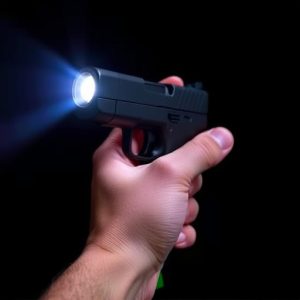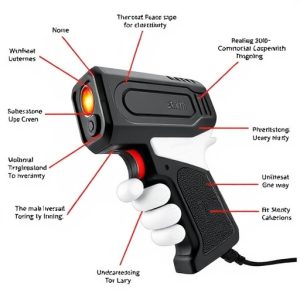Decoding Stun Gun Effectiveness: Mechanisms, Factors, and Real-World Applications
Stun guns function by delivering a high-voltage, low-current electrical shock that causes muscle co…….
Stun guns function by delivering a high-voltage, low-current electrical shock that causes muscle contractions and disorientation, effectively incapacitating an individual. They consist of multiple probes connected to a power source, which, when activated, emit a charge that triggers rapid neuronal depolarization and skeletal muscle twitches. The intensity and duration of the shock are adjustable, ranging from mild discomfort to complete incapacitation. Factors such as probe design, power source output, and electrical characteristics like voltage and current significantly impact their effectiveness. Safety features, including charge gauges and various intensity settings, help ensure proper use and understanding of the device's limitations, which can be influenced by external factors like weather and clothing, as well as individual physiology. Understanding how does a stun gun work is crucial for effective self-defense or law enforcement applications, taking into account user skill, situational awareness, environmental conditions, and the dynamics between the user and the target. Stun guns, also known as electroshock weapons like Tasers, are non-lethal devices used by law enforcement to subdue suspects without resorting to deadly force and serve as deterrents in personal defense scenarios. Their user-friendly designs and various models, including handheld units and stun gun flashlights, allow for effective integration into personal defense strategies. They are essential tools for non-lethal weaponry, providing a temporary disruption of the body's motor functions without inflicting lasting harm, thus enhancing safety for both individuals and institutions.
When considering personal safety or law enforcement, the discussion often turns to the role of stun guns as non-lethal defense mechanisms. This article delves into the effectiveness of stun guns, exploring their mechanics and the factors that influence their performance in self-defense scenarios and professional settings. By understanding how a stun gun works, readers can gain insight into its reliability and limitations. We will analyze the impact of various elements on their efficacy, from voltage output to the target’s physiology, ensuring a comprehensive examination of stun guns as a defensive tool.
Understanding Stun Gun Mechanisms: An Overview of How They Work
Stun guns, also known as electric stun devices or electroshock weapons, are non-lethal self-defense tools that incapacitate target individuals through the delivery of a high-voltage, low-current electrical shock. To understand how a stun gun works, one must delve into its core components and the scientific principles behind their operation. At the heart of a stun gun lies the electroshock array, typically composed of two or more probes connected to a power source. When activated, the device emits an electrical charge that travels from one probe to another through the target’s body, causing muscle contractions and disorientation. This effect is due to the rapid depolarization of neuronal membranes, which triggers the involuntary twitch response in skeletal muscles. The intensity and duration of the shock can be modulated by the device’s settings, allowing for a range of effects from a discomforting jolt to a debilitating incapacitation.
The effectiveness of stun guns is contingent upon several factors, including the design of the probes, the power source’s capacity, and the electrical characteristics such as voltage and current. Stun guns are distinct from other electroshock devices due to their contact delivery system; they require physical contact with the target to deliver an effective shock. The design often incorporates features like a charge gauge, which indicates when the device is fully charged, and varying levels of intensity for different scenarios. It’s crucial for users to understand the limitations and proper usage of stun guns, as their effectiveness can be compromised by factors such as weather conditions, clothing thickness, and the physiological characteristics of the target individual. Understanding these mechanisms is essential for anyone considering a stun gun for self-defense or law enforcement purposes, as it provides insight into how they work and the circumstances under which they are most effective.
Factors Influencing the Effectiveness of Stun Guns in Self-Defense
The effectiveness of stun guns as a self-defense tool is influenced by several key factors, each contributing to their operational success in critical situations. Understanding how does a stun gun work is fundamental, as it relies on delivering an electrical shock to incapacitate an attacker. This non-lethal device emits a high-voltage, low-ampere electrical charge that targets the muscle groups of the body, causing intense pain and muscle spasms. The intensity of this electric current can be modulated through various features such as voltage levels and electrode configurations. A stun gun’s effectiveness is contingent upon its proper deployment; factors like user proficiency, the correct application to the body’s muscle masses, and the timing of the shock delivery play pivotal roles in their efficacy. Environmental conditions, such as weather and terrain, can also impact performance. For instance, damp or wet environments may reduce the effectiveness of a stun gun due to electrical resistance. Similarly, thick clothing can diminish the current’s ability to penetrate and affect the target’s nervous system. In conclusion, the effectiveness of stun guns in self-defense scenarios is not solely dependent on the device’s technical specifications but also on user knowledge, situational context, environmental factors, and the physical and physiological characteristics of both the user and the attacker.
Evaluating the Impact of Stun Guns in Law Enforcement and Personal Safety Contexts
Stun guns, often misunderstood due to their misnomer, are electronic devices designed to incapacitate an individual by delivering a high-voltage, low-current electrical shock. This non-lethal tool is employed by law enforcement agencies worldwide as a means to subdue adversaries without resorting to deadly force. In the context of personal safety, stun guns serve as a deterrent and a defense mechanism for individuals facing threatening situations. The effectiveness of stun guns in both scenarios hinges on their ability to cause an involuntary muscle spasm, temporarily immobilizing the target. This is achieved through two main conductive probes that deliver the electric charge upon contact with a person.
When evaluating the impact of stun guns within law enforcement, one must consider their role in de-escalation scenarios, where the potential for injury or death from firearms is significant. Stun guns provide an alternative that can save lives on both sides of an encounter. In personal safety contexts, the effectiveness is more individualized, relying on factors such as proper training, situational awareness, and the user’s presence of mind during a crisis. The devices are designed to be user-friendly, with models ranging from handheld units to stun gun flashlights, ensuring that individuals can learn to use them effectively as part of a comprehensive personal defense strategy. How they work is a matter of electrical principles: the electric current interferes with the body’s motor functions, causing disorientation and immobility without causing permanent harm. This makes stun guns a valuable tool for self-defense and a critical component in non-lethal weaponry arsenals across various agencies.


